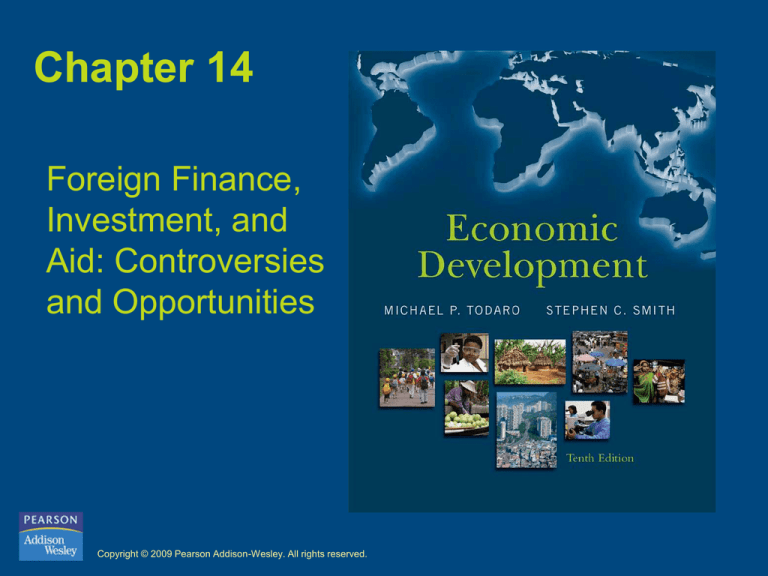
Chapter 14
Foreign Finance,
Investment, and
Aid: Controversies
and Opportunities
Copyright © 2009 Pearson Addison-Wesley. All rights reserved.
The International Flow of
Financial Resources
• Three sources:
– Private direct and portfolio investment
– Remittances of earnings by international
migrants
– Public and private development assistance
Copyright © 2009 Pearson Addison-Wesley. All rights reserved.
14-2
Private Foreign Direct Investment
and the Multinational Corporation
• Definition of MNC
– Recent growth of foreign direct investment (FDI)
Copyright © 2009 Pearson Addison-Wesley. All rights reserved.
14-3
Figure 14.1 FDI Inflows, 1980–
2005
Copyright © 2009 Pearson Addison-Wesley. All rights reserved.
14-4
Figure 14.2 FDI Inflows to Developing
Countries in Relation to Domestic
Investment,1990–2003
Copyright © 2009 Pearson Addison-Wesley. All rights reserved.
14-5
Figure 14.3 Total Net Resource Flows
to Developing Countries, 1990–2005
Copyright © 2009 Pearson Addison-Wesley. All rights reserved.
14-6
Private Foreign Direct Investment
and the Multinational Corporation
• Multinational corporations: size, patterns,
and trends
• Private foreign investment: pros and cons
for development
Copyright © 2009 Pearson Addison-Wesley. All rights reserved.
14-7
Private Foreign Investment: Pros
and Cons for Development
• Traditional arguments in support of private
investment: Filling savings, foreign
exchange, revenue, and management gaps
– Four main arguments
Copyright © 2009 Pearson Addison-Wesley. All rights reserved.
14-8
Private Foreign Investment: Pros
and Cons for Development
• Traditional arguments against private
foreign investment: Widening gaps
– Two main perspectives of the arguments:
Economic and ideological
– transfer pricing
• Reconciling pros and cons
Copyright © 2009 Pearson Addison-Wesley. All rights reserved.
14-9
Table 14.1 Seven Key Disputed Issues about
the Role and Impact of Multinational
Corporations in Developing Countries
Copyright © 2009 Pearson Addison-Wesley. All rights reserved.
14-10
Table 14.1 Seven Key Disputed Issues about the
Role and Impact of Multinational Corporations in
Developing Countries (continued)
Copyright © 2009 Pearson Addison-Wesley. All rights reserved.
14-11
Private Portfolio Investment: Boon
or bane for LDCs?
• What is portfolio investment?
• Emerging-country stock markets
Copyright © 2009 Pearson Addison-Wesley. All rights reserved.
14-12
The role and Growth of
Remittances
• Wage differences
• “Brain Drain”
• Uneven flow of remittances
Copyright © 2009 Pearson Addison-Wesley. All rights reserved.
14-13
Figure 14.4 Resource Flows to
Developing Countries, 1990–2005
Copyright © 2009 Pearson Addison-Wesley. All rights reserved.
14-14
Figure 14.5 Top 20 Remittance
Recipient Countries, 2004
Copyright © 2009 Pearson Addison-Wesley. All rights reserved.
14-15
Foreign Aid: The Development
Assistance Debate
• Conceptual and measurement problems
• Amounts and allocations: public aid
– Official development assistance (ODA)
Copyright © 2009 Pearson Addison-Wesley. All rights reserved.
14-16
Table 14.2 Official Development Assistance
Disbursements from Major Donor Countries,
1985, 2002, and 2005
Copyright © 2009 Pearson Addison-Wesley. All rights reserved.
14-17
Table 14.3 Official Development
Assistance (ODA) by Region, 2005
Copyright © 2009 Pearson Addison-Wesley. All rights reserved.
14-18
Foreign Aid: The Development
Assistance Debate
• Why donors give aid
– political motivations
– economic motivations:
• Foreign exchange constraints (two gap model)
• Growth and savings
• Technical assistance
• Absorptive capacity
• Self interest
Copyright © 2009 Pearson Addison-Wesley. All rights reserved.
14-19
Foreign Aid: The Development
Assistance Debate
The two-gap model:
savings constraint
I F sY
(15.1)
Where
I is domestic investment
F is the amount of capital inflows
s is the savings rate
Y is national income
Copyright © 2009 Pearson Addison-Wesley. All rights reserved.
14-20
Foreign Aid: The Development
Assistance Debate
The two-gap model:
foreign-exchange constraint
(m1 m2 ) I m2 Y E F
(15.2)
Where
I is domestic investment
F is the amount of capital inflows
E is the level of exports
Y is national income
m1 is the marginal import share
m2 is the marginal propensity to
import
Copyright © 2009 Pearson Addison-Wesley. All rights reserved.
14-21
Foreign Aid: The Development
Assistance Debate
• Why LDC recipients accept aid
• The role of nongovernmental organizations
(NGOs)
• The effects of aid
Copyright © 2009 Pearson Addison-Wesley. All rights reserved.
14-22
Conclusions: Toward a New
View of Foreign Aid
• Dissatisfaction among donors and recipients
may create the possibility for new aid
arrangements
• Future aid is likely to be linked to market
reforms and institutional capacity-building
Copyright © 2009 Pearson Addison-Wesley. All rights reserved.
14-23
Case Study: Botswana
Copyright © 2009 Pearson Addison-Wesley. All rights reserved.
14-24
Concepts for Review
• Absorptive capacity
• Foreign-exchange gap
• Aid weariness
• Global factories
• Concessional terms
• Economic transition
• Multinational
corporation (MNC)
• Emerging-country
stock markets
• Nongovernmental
organizations (NGOs)
• Foreign aid
• Official development
assistance (ODA)
• Foreign direct
investment (FDI)
Copyright © 2009 Pearson Addison-Wesley. All rights reserved.
14-25
Concepts for Review (cont’d)
• Portfolio investment
• Technical assistance
• Productive resources
• Tied aid
• Savings gap
• Transfer pricing
• Two-gap model
Copyright © 2009 Pearson Addison-Wesley. All rights reserved.
14-26








